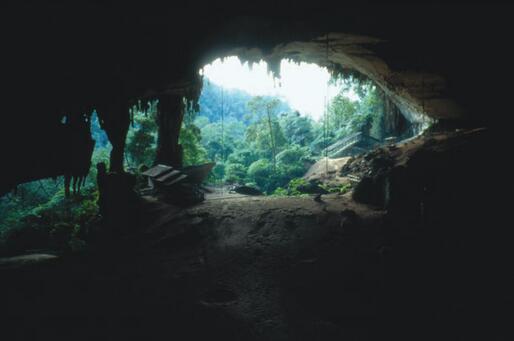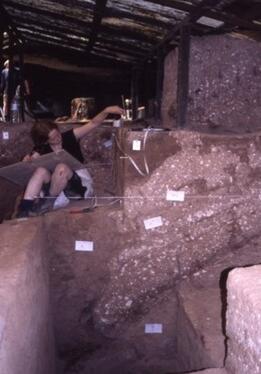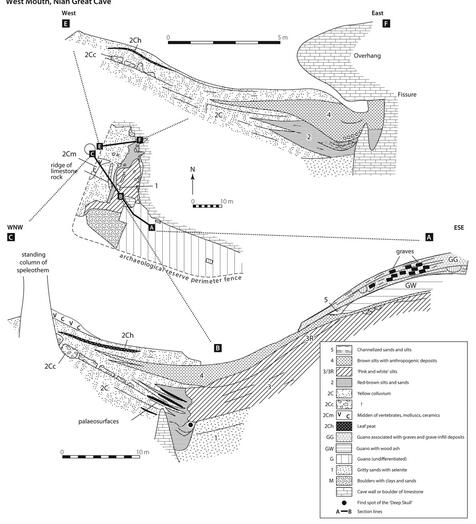Rainforest Foraging and Farming in Island Southeast Asia:50 Millennia of Prehistory at the Niah Caves, Borneo
From:Shanghai Archaeology Forum NetWriter:University of CambriDate:2017-12-10
The Niah Caves lie within the Gunung Subis, a 200-metre high limestone massif near the northern coast of Borneo in Sarawak, East Malaysia. The cliffs of the Gunung Subis are riddled with caves and fissures, but the system is dominated by the cathedral-like Great Cave. Multi-chambered and multi-entranced, the Great Cave measures some 900 m by 600 m and soars to a height of c.100 m. The caves are at the centre of Niah National Park, an island of primary and secondary rainforest in the middle of what is now a sea of palm-oil plantation covering much of this part of coastal Sarawak. The caves have iconic status in the archaeology of Island Southeast Asia as a result of the excavations by Tom and Barbara Harrisson in the 1950s and 1960s in a series of entrances to the Great Cave but especially in the West Mouth. Their most spectacular discovery here, in 1958, was that of an anatomically modern human cranium referred to as the ‘Deep Skull’ that was dated by adjacent charcoal to around 40,000 years ago, making it at the time the earliest Homo sapiens fossil in the world. The Deep Skull and other post-cranial remains were part of some 2 m of occupation debris termed by the Harrissons the ‘frequentation zone’ and dated by them to the Late Pleistocene and Early Holocene. Higher up were hundreds of graves associated with Neolithic and Metal Age pottery, the largest prehistoric cemetery in Island Southeast Asia. Until the discovery a few years ago of Homo sapiens fossil remains of similar antiquity to the Deep Skull in Sri Lanka, Niah Great Cave was the only site between Africa and Australia providing direct fossil evidence in support of the theory of the ‘Southern Route’ of dispersal of modern humans from Africa to Australia.
The Harrissons and their collaborators published many articles on the results of their excavations but for a variety of reasons were not able to bring the work together in a final report so many questions remained about their discoveries, especially regarding the age of the Deep Skull. This was the context for a detailed reinvestigation of the caves beginning in 2000 by an interdisciplinary team of archaeologists, geographers, and other environmental scientists. The focus has been on the human occupation history of the caves and the climatic and environmental contexts in which it was situated.

The new work focussed on the West Mouth, but we also undertook excavations in other entrances to the Great Cave and in other smaller caves in the vicinity that had been explored by the Harrissons. The Niah Caves Project, as the new work at Niah has been termed, set out to address three main research questions. First, how old was human presence in the caves, and the Deep Skull in particular? Second, was there rainforest around the cave in the Late Pleistocene, and if so, were the first modern humans capable of living in it? (There had been a rigorous debate in the previous decade amongst anthropologists and archaeologists about whether foragers could live in rainforest without recourse to trading with neighbouring farmers, given the dearth of plant staples.) Third, when and in what circumstances did foraging give way to farming? The context of the third question was to test the widely-accepted theory that farming was introduced to Island Southeast Asia by Neolithic colonists from Taiwan and ultimately mainland China who brought with them Neolithic material culture and domestic rice and pigs.

The main fieldwork took place in 2000-2003 and the materials from this work, along with the prolific archive of the Harrisson excavations that includes hundreds of thousands of animal bone fragments, many thousands of pot sherds and shells, hundreds of human skeletons, and numerous artefacts of stone, bone and wood, beads, and textile fragments, have been the focus of study ever since by a team of PhD students, post-doctoral researchers and senior collaborators. The earlier excavations removed most of the archaeological sediments in the West Mouth and other cave entrances, so we set out to undertake as small-scale excavations as possible to collect the kind of information we needed, so as to leave the archaeology as intact as possible at the end of the project. The faces of the Harrisson trenches in the West Mouth and other entrances were cleaned and recorded to modern standards, and a wide variety of sediment samples was collected for dating purposes and for the extraction of climate proxies such as pollen and phytoliths. A baulk or section wall remaining near the findspot of the Deep Skull was completely excavated in particular for faunal and botanical remains indicative of the subsistence activities of the first visitors to the site. Small-scale excavations were undertaken of particular burials in the Neolithic cemetery to investigate funerary behaviour. In total around 75 scholars have contributed to the two monographs published on the project: Rainforest Foraging and Farming in Island Southeast Asia: the Archaeology of the Niah Caves, Sarawak (Cambridge: McDonald Institute Monograph 2013, 410 pp., ISBN 978-1-902937-54-0, edited by Graeme Barker) and Archaeological Investigations in the Niah Caves, Sarawak (Cambridge: McDonald Institute Monograph 2016, 562 pp. and 339 pp. Supplementary Materials, ISBN 978-1-902937-60-1). It is their work that has deserved the accolade of this award.
Our geomorphological studies in the West Mouth revealed an extremely complex sequence of events over the past c.53,000 years within which the human activity has to be understood. A natural basin behind the cave lip was filled with four major sediment types or lithofacies. At the base were brown and red silts (Lithofacies 2) formed by episodes of water flowing into the basin from the cave interior, presumed to relate to more humid phases. Interleaved with these sediments were colluvial sediments formed by materials slumping, sliding and washing down from the cave mouth (Lithofacies 2C). Traces of human activity were found in both lithofacies (charcoal, ash, animal bone, stone tools etc), especially associated with palaeosurfaces indicating intermittent rather than continuous presence. Charcoal samples dated by the Oxford laboratory indicate a timescale within which these visits took place of c.50,000-35,000 years ago. Lithofacies 2 and 2C were capped by archaeologically-sterile sediments (Lithofacies 3) termed ‘pink and white’ by Tom Harrisson that he thought had been formed over thousands of years as a steady drizzle of bat guano (the pink) and limestone fragments (the white) from the cave roof, but in fact they resulted from a sudden avalanche of wet guano from the cave interior that may have lasted for just minutes, hours or a few days, sometime around 35,000 years ago. Overlying the ‘pink and white’ were brown silts and thick accumulations of ash with abundant evidence of human presence, termed Lithofacies 4, radiocarbon dates indicating that they formed in the Late Pleistocene and Early Holocene. The main sediments of the Mid and Late Holocene are bat and bird guano.

The sequence of climatic and environmental change preserved in the cave sediments is synchronous with the sequence of interstadial (warm/wet) and stadial (cold/dry) events established for the northern hemisphere (Marine Isotope Stages 4-1). The sea came right up to the caves at the height of interstadial phases whereas in stadial phases such as the Last Glacial Maximum c.20,000 years ago, lowered sea levels enlarged the coastal plain by well over 100 kilometres from its present configuration. At the height of interstadial climatic phases there was dense tropical rainforest similar to today’s, whereas stadial phases were characterised by drier more open but still predominantly forested landscapes that included plant and animal species now present in the mountains 1000 metres above sea level. In between were phases with a mixture of dry scrub, dry lowland mixed forest and montane forest.
We were able to obtain a direct uranium-series date on the Deep Skull, which belonged to an adult female, of around 37,000 years ago. This was surprising because we had obtained dates of c.40-45,000 years ago from sediments c.20-50 cm above where we calculated it had been found. Our analyses of sediments adhering to the skull, and of the pollen in them, found that they were a mix of the kind of material we would have expected at the depth the skull was buried and the occupation sediments above it. The skull was found with some limb bones, and we conclude that it was probably a secondary burial of some kind, with a pit being dug down (not noticed by the original excavators) and some disarticulated bones and the skull placed in it, resulting in the mix of Lithofacies 2 and 4 sediments adhering to the skull. One intriguing find in the sediments from the skull were quartz crystals that derive from granite rocks hundreds of miles away, including on the summit of Mount Kinabalu 4000 m above sea level. It is difficult to imagine how these bright attractive crystals could have arrived at Niah except by human agency.
Hominins, almost certainly anatomically modern humans, were regularly visiting the caves from at least 50,000 years ago, and were clearly able to live successfully in rainforest. Their stone technologies, as at other Upper Pleistocene sites in island Southeast Asia, consist almost entirely of unretouched flakes of locally-available stone, mostly river pebbles. Studies of microscopic traces of use wear and organic residues attached to the surfaces of these ‘simple’ flakes provide strong circumstantial evidence for the importance of organic technologies. They were used for a variety of functions including scraping and cutting hard materials such as bone and wood (polish on several flakes is consistent with cutting or slicing materials such as bamboo and rattan), working soft plant material, and cutting or scraping tree resin. As well as resin, organic residues on the tools included bird feather fragments, plant cellulose tissues, and starch granules, indicating that the stone tools were being used for a variety of tasks including processing food plants, butchering mammals and birds, and perhaps craft activities such as basket making. From the outset people also fashioned pieces of bone and pig tusk into points and various kinds of scraping and piercing tools, the high levels of use wear indicating that they were intensively used and curated. The first modern humans in Island Southeast Asia may have had access only to unpromising lithic raw materials compared with, for example, contemporary hunter-gatherers in Africa and western Eurasia, but the technologies they developed using stone and the many other materials available to them in the forests were highly complex.

At Niah the first foragers hunted bearded pig as well as a wide variety of large and small prey including ones high in the forest canopy such as orang-utan, macaques, leaf monkeys and langurs, and, on the forest floor, sambar deer, muntjac, porcupine, sun bear, pangolin and even rhinoceros. They were able to hunt these because the location of the caves gave walking access to a mosaic of environments including riparian forest, lowland rainforest, hill rainforest, and even montane vegetation. The same mosaic meant they could collect edible molluscs from rivers, streams, ponds and swamps, where they also fished. The killing ages of the major prey species imply that the hunters used traps and snares to catch them. One of the most intriguing aspects of the butchery evidence is variability in the methods applied to different primates and viverrids that is difficult to explain in functional terms such as relating to the mechanical properties of particular bones, hinting that these early modern humans divided up the animal world very differently from our own Linnaean classifications.
Starch grains on the stone artefacts and macroscopic plant remains such as plant parenchyma (tissue) recovered by water flotation show that these forest foragers were also harvesting a rich suite of rainforest plant resources, especially nuts, fruits and tubers. The latter included yams and palms such as sago, the plant that provides the main carbohydrate for present-day Penan foragers in Bornean rainforests. Some of these plant foods are highly toxic, and one of the most remarkable discoveries was evidence that people had learnt how to extract the toxins by burying toxic plants and nuts in ash-filled pits to make them edible, a technique used by tropical Australian aborigines. Peaks in Justicia pollen and charcoal coinciding with the episodes of human activity suggest that from the outset these people were also burning forest to make or enlarge cleared spaces, presumably to encourage the growth of plants such as tubers, which they themselves wanted and which would also have attracted game. Similar evidence for forest burning associated with human occupations around 50,000 years ago has been found in interior New Guinea. The terms ‘vegeculture’ and ‘arboriculture’ have been proposed to describe the systems of forest management being practised in Island Southeast Asia in the Early Holocene thousands of years before rice agriculture developed. The Niah evidence hints that these behaviours may be of deeper antiquity, part of the remarkable suite of strategies developed by modern humans to live in rainforest as they first encountered it.
Thick deposits of ash in the West Mouth indicate that the frequency and character of occupation intensified significantly after the Last Glacial Maximum, as dense rainforest developed around the caves. Organic technologies became increasingly important and included hafted composite projectiles such as two stingray barbs still with fibres and resin attached. The lightness of these and other projectile heads suggests that they may have been mainly designed as fishing harpoons though spears and bows and arrows were also used for hunting. (The blow pipe came much later in the Holocene, when metal tools were available.) In the Early Holocene people camped in other entrances to the Great Cave but the West Mouth was used as a place of burial. Funerary norms were extraordinarily varied: parts of bodies were buried as the Deep Skull female had been, or whole bodies were laid out extended, or bent in the foetal position, sometimes with the head separated from the body, or even placed seated onto a fire at the base of a pit. People continued to live by forest foraging and the pollen record shows that they continued to have significant effects on the landscape around the cave.
After a gap of several thousand years in the Mid Holocene when the sea surrounded the caves, people with Neolithic material culture but of the same physical character as before returned to Niah around 4000 years ago to bury their dead. They used forms of burial that were at first like those of the Early Holocene but with social categories such as age and gender more clearly differentiated and likely involving the veneration of immediate and recent ancestors. They cultivated rice on a small scale alongside practising traditional forms of foraging and ‘vegeculture’ (plant management), but they abandoned rice cultivation after a few centuries, and did not have domestic livestock. Our findings fit an emerging body of scholarship that is increasingly sceptical of the ‘Austronesian hypothesis’ of a maritime dispersal of voyager-farmers from Taiwan c.4000 BP. They emphasize instead the likely importance of new kinds of social relations and possibly ideologies that linked the coastal communities of Mainland Southeast Asia, Island Southeast Asia and Melanesia through maritime networks of contact.
Many of the Niah Caves continued to be used as burial places in the ‘Metal Age’ c. 2000-500 BP or AD 0-1500. Exotic grave goods (pottery, glass beads, shell and metal artefacts) were obtained by participation in trading networks that linked Island Southeast Asia not just with Mainland Southeast Asia but India and China. People continued to live by a combination of forest foraging, vegeculture, and small-scale agriculture including keeping domestic pigs, and for the past 1000 years also collected swiftlet nests to trade with Chinese merchants. Extraordinarily, despite thousands of years of acquaintance with it, rice only became a staple food in recent centuries.
The headline result of the Niah Caves Project is that the rainforests of Borneo have been shaped and managed by people for at least 50,000 years. Rather similar rainforest histories are emerging from other parts of the world such as West Africa, Central America and the Amazon basin, but the Niah Caves’ ‘archaeological history’ is both the longest and richest, described by one reviewer (World Archaeology 2015) as “unsurpassed worldwide in the context of reconstructing…human rainforest subsistence foraging strategies”. Today Penan foragers in Borneo practise what they call ‘molong’ or ‘landscape nurturing’, for example protecting stands of sago palms by removing competitor vegetation from around them. The Niah Caves’ evidence suggests that rainforest management strategies may be more as old as our species’ engagement with them, a finding of significant implications for present-day rainforest conservation theory and practice based on the assumption that rainforests have been more or less pristine environments until people started to have significant impacts on them in the last 100-200 years.

